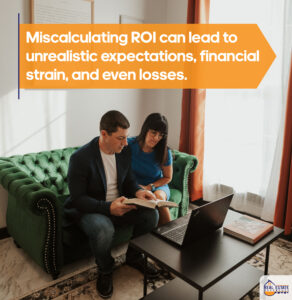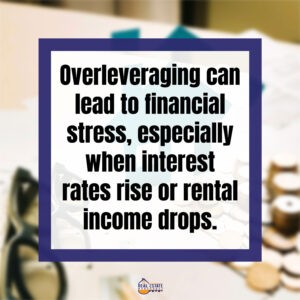Real estate investing can be a lucrative way to build wealth and achieve financial freedom. However, it’s also a field filled with potential pitfalls for both novice and seasoned investors alike. Whether you’re just getting started or you’re looking to sharpen your existing strategy, being aware of the most common mistakes and how to avoid them is essential for long-term success.
In this guide, we’ll explore some of the most common mistakes real estate investors make and, most importantly, how you can avoid them to protect your investments and boost your returns.
1. Overleveraging Investments
One of the most dangerous mistakes in real estate investing is overleveraging—relying too heavily on borrowed money to finance your investments. While leverage can magnify your gains, it can also magnify your losses if the market turns or the property fails to perform as expected.
The Risk:
- Overleveraging can lead to financial stress, especially when interest rates rise or rental income drops. Investors may find themselves struggling to cover mortgage payments, taxes, and maintenance, risking default or foreclosure.
How to Avoid It:
- Maintain a balanced portfolio with healthy equity. Aim to finance properties conservatively, keeping some of your own capital invested to reduce risk.
- Build an emergency fund to cover unexpected vacancies, repairs, or market downturns. This safety net will protect you if your cash flow temporarily decreases.
- Focus on positive cash flow properties, where rental income covers all expenses, and avoid speculative investments that rely purely on future appreciation to turn a profit.
2. Failing to Conduct Proper Market Research
Investing in real estate without fully understanding the local market is like sailing a ship without a compass—it’s risky, and you’re more likely to run aground. Market research helps you make informed decisions, ensuring that you purchase properties in areas with strong growth potential and tenant demand.
The Risk:
- A lack of market research can lead to purchasing properties in declining neighborhoods or overpaying for properties with little future growth.
- Without understanding local rental trends, investors may also struggle to set competitive rents, leading to higher vacancy rates.
How to Avoid It:
- Study local market trends, including property values, rental rates, job growth, and demographic shifts. Understanding these factors will help you assess a neighborhood’s long-term potential.
- Visit the neighborhood at different times of the day and week to get a true sense of its livability.
- Consult with local real estate agents or property managers who understand the area and its challenges.
3. Underestimating Maintenance and Repair Costs
A common mistake, especially for new investors, is underestimating how much it costs to maintain and repair properties. Real estate, unlike other investments, requires ongoing upkeep, and failing to account for these costs can quickly eat into your profits.
The Risk:
- Major repairs, such as replacing a roof or updating a property’s plumbing, can be costly, especially if not budgeted for.
- Ignoring maintenance or deferring repairs can reduce your property’s value over time and make it harder to attract quality tenants.
How to Avoid It:
- Before purchasing a property, get a professional inspection to uncover any hidden issues and provide accurate repair estimates.
- Set aside 1-2% of the property’s value annually for repairs and maintenance.
- Develop a proactive maintenance plan to keep the property in good condition and avoid costly emergency repairs.
4. Not Having a Clear Investment Strategy
Jumping into real estate without a clear strategy is a sure way to fail. Many investors buy properties on a whim, based on market hype or emotional attachment, without considering whether the property fits their long-term goals.
The Risk:
- Without a plan, investors can end up overpaying for properties, making poor investment decisions, or holding onto underperforming assets for too long.
- Different investment strategies (e.g., buy-and-hold, fix-and-flip, or short-term rentals) require different approaches, and a lack of focus can lead to poor returns.
How to Avoid It:
- Define your investment strategy before you start buying properties. Are you focused on long-term rentals? Fix-and-flips? Commercial properties?
- Stick to your strategy and be patient. Real estate investing is a marathon, not a sprint, and staying focused will help you avoid distractions and poor decisions.
- Regularly review and update your strategy based on market conditions and your financial goals.
5. Miscalculating Return on Investment (ROI)
Many investors fail to accurately calculate their return on investment (ROI) by overlooking important costs like taxes, insurance, and vacancies. When these costs aren’t factored in, it’s easy to overestimate profits and make poor investment choices.
The Risk:
- Miscalculating ROI can lead to unrealistic expectations, financial strain, and even losses.
- Properties that seem profitable at first glance may turn into money pits if all expenses aren’t accounted for.
How to Avoid It:
- When calculating ROI, include every possible expense, from property taxes and insurance to management fees and vacancy periods.
- Be conservative in your estimates, especially for rental income. Always assume there will be vacancies or periods when rent is late.
- Factor in appreciation, but don’t rely solely on it. Focus on cash flow as your primary metric for profitability.
6. Ignoring Location Importance
It’s said in real estate that location is everything, and for good reason. Even the best property in the wrong location can be a poor investment. Whether you’re buying to rent or to flip, location will significantly impact both your short-term cash flow and long-term appreciation.
The Risk:
- Investing in a property in a less desirable location can lead to higher vacancy rates, lower rental income, and difficulty selling when the time comes.
- Even if the property is affordable, a poor location can make it difficult to find quality tenants or buyers.
How to Avoid It:
- Choose properties in areas with strong job markets, good schools, and low crime rates. These factors attract reliable tenants and support long-term appreciation.
- Look for areas with growing infrastructure and development. Proximity to transportation, shopping, and entertainment will increase your property’s desirability.
- Avoid “bargain” properties in bad neighborhoods unless you’re prepared for the risks involved, such as higher maintenance and vacancy rates.
7. Skipping Due Diligence
Due diligence is the process of thoroughly investigating a property before purchasing. Skipping this critical step can result in costly mistakes, from buying properties with hidden structural issues to entering markets that don’t align with your goals.
The Risk:
- Without thorough due diligence, investors may end up with properties that have serious flaws, legal issues, or inflated valuations.
- Failing to assess the neighborhood or the property’s rental potential can lead to underperforming investments.
How to Avoid It:
- Always conduct a thorough inspection of the property. Hire professionals to assess the structure, foundation, roof, plumbing, and electrical systems.
- Review local zoning laws, environmental regulations, and potential property tax changes.
- Investigate the history of the property and neighborhood to uncover any potential red flags, such as future developments that could negatively impact property value.
8. Overpaying for Properties
In a competitive market, it’s easy to get caught up in bidding wars and overpay for properties. While it may seem like a small overbid, this can have significant consequences on your long-term returns.
The Risk:
- Overpaying reduces your ability to generate positive cash flow and can make it difficult to recoup your investment.
- In slow markets, you may struggle to sell the property for a profit, tying up your capital in an underperforming asset.
How to Avoid It:
- Set a maximum price for every property and stick to it. Don’t get emotionally attached or let FOMO (fear of missing out) dictate your decisions.
- Use comparables (comps) to ensure you’re paying a fair market price for the property.
- Consider the property’s long-term potential, but focus on its current value and cash flow capabilities.
9. Neglecting Tenant Screening
Many investors are so eager to fill vacancies that they skip thorough tenant screening, only to regret it later. Bad tenants can lead to property damage, late payments, and costly evictions.
The Risk:
- A bad tenant can turn a profitable rental into a nightmare, with unpaid rent, legal fees, and property damage eating into your returns.
How to Avoid It:
- Implement a comprehensive tenant screening process that includes credit checks, employment verification, and references from previous landlords.
- Don’t rush the process. It’s better to leave a unit vacant for a little longer than to fill it with a tenant who will cause problems.
- Use property management software or hire a property manager to handle tenant screening and ongoing maintenance.
10. Not Having an Exit Strategy
Real estate investing is about long-term success, but it’s essential to have an exit strategy in place for when you’re ready to sell. Without a plan, you may hold onto underperforming assets for too long, missing out on better opportunities.
The Risk:
- Investors without exit strategies may struggle to sell properties at the right time, leaving money on the table or even taking losses during market downturns.
How to Avoid It:
- Decide your exit strategy before purchasing each property. Will you sell after a certain period, refinance, or complete a 1031 exchange?
- Regularly review market conditions and your investment goals. Be ready to act when market conditions align with your exit strategy.
- Consider tax implications, capital gains, and market cycles when planning your exit.
Achieving Long-Term Success in Real Estate
Real estate investing is an exciting path to financial freedom, but it’s essential to approach it with caution and strategy. By understanding and avoiding these common mistakes—such as overleveraging, skipping due diligence, and underestimating costs—you can build a successful portfolio that generates steady income and long-term growth.
Remember, real estate is a marathon, not a sprint. With proper planning, thorough research, and a proactive approach, you can navigate the complexities of the market, minimize risks, and achieve the kind of financial success that lasts for years to come.
The key to thriving in real estate is continuous learning, strategic planning, and staying adaptable to ever-changing market conditions. Keep refining your approach, seek advice from seasoned professionals, and remain disciplined in your investment decisions to ensure sustained success in the world of real estate.
Happy investing,
Dan & Jenni Innarella







